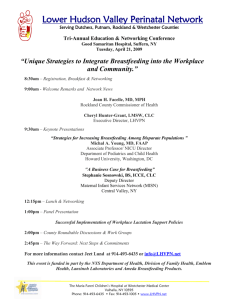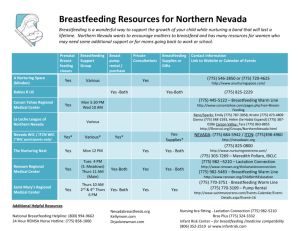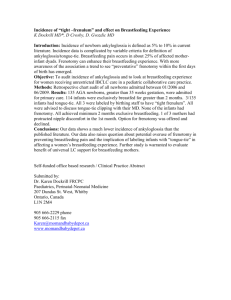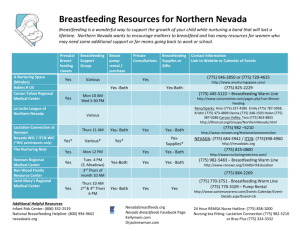BPS2009-2
advertisement
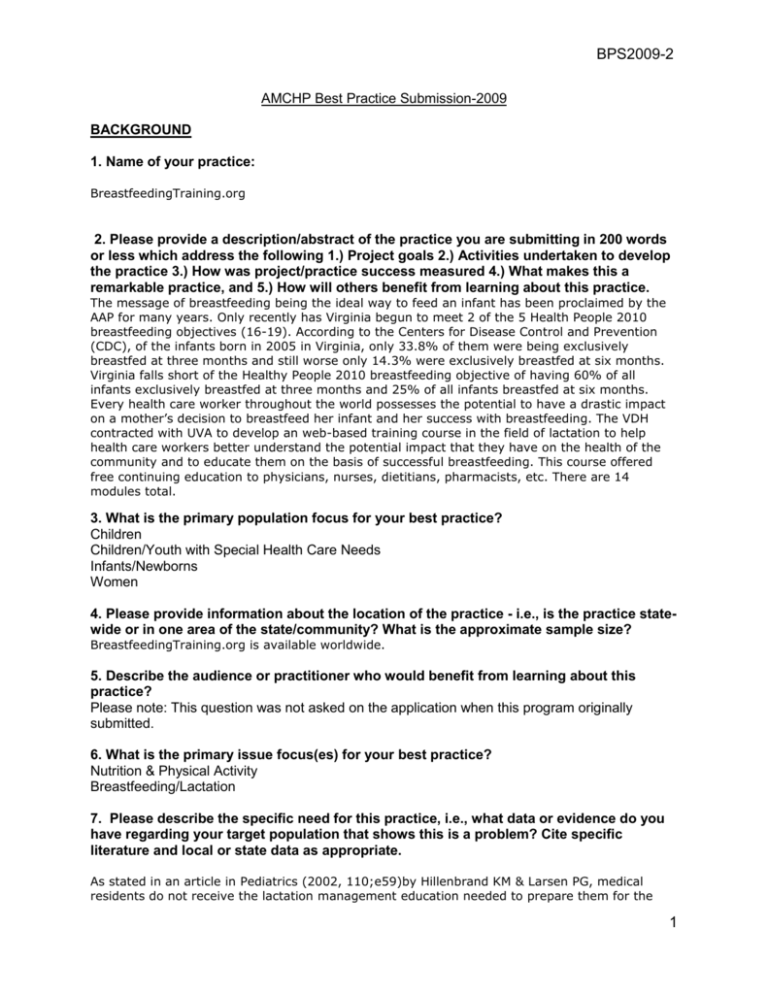
BPS2009-2 AMCHP Best Practice Submission-2009 BACKGROUND 1. Name of your practice: BreastfeedingTraining.org 2. Please provide a description/abstract of the practice you are submitting in 200 words or less which address the following 1.) Project goals 2.) Activities undertaken to develop the practice 3.) How was project/practice success measured 4.) What makes this a remarkable practice, and 5.) How will others benefit from learning about this practice. The message of breastfeeding being the ideal way to feed an infant has been proclaimed by the AAP for many years. Only recently has Virginia begun to meet 2 of the 5 Health People 2010 breastfeeding objectives (16-19). According to the Centers for Disease Control and Prevention (CDC), of the infants born in 2005 in Virginia, only 33.8% of them were being exclusively breastfed at three months and still worse only 14.3% were exclusively breastfed at six months. Virginia falls short of the Healthy People 2010 breastfeeding objective of having 60% of all infants exclusively breastfed at three months and 25% of all infants breastfed at six months. Every health care worker throughout the world possesses the potential to have a drastic impact on a mother’s decision to breastfeed her infant and her success with breastfeeding. The VDH contracted with UVA to develop an web-based training course in the field of lactation to help health care workers better understand the potential impact that they have on the health of the community and to educate them on the basis of successful breastfeeding. This course offered free continuing education to physicians, nurses, dietitians, pharmacists, etc. There are 14 modules total. 3. What is the primary population focus for your best practice? Children Children/Youth with Special Health Care Needs Infants/Newborns Women 4. Please provide information about the location of the practice - i.e., is the practice statewide or in one area of the state/community? What is the approximate sample size? BreastfeedingTraining.org is available worldwide. 5. Describe the audience or practitioner who would benefit from learning about this practice? Please note: This question was not asked on the application when this program originally submitted. 6. What is the primary issue focus(es) for your best practice? Nutrition & Physical Activity Breastfeeding/Lactation 7. Please describe the specific need for this practice, i.e., what data or evidence do you have regarding your target population that shows this is a problem? Cite specific literature and local or state data as appropriate. As stated in an article in Pediatrics (2002, 110;e59)by Hillenbrand KM & Larsen PG, medical residents do not receive the lactation management education needed to prepare them for the 1 BPS2009-2 clinical encounters with breastfeeding mothers. Many other healthcare workers fall into the same pitfall. This course was developed as a convenient way to educate healthcare professionals that offers free CEUs, CMEs, and CPEs and can be accessed from anywhere there is a computer with web access available. 8. What are the overall goals and key objectives of your practice? Each of the 14 Modules provide their own specific objectives, but the overall goal is: Breastfeeding is a very important public health issue. Most medical experts agree that breastfeeding enhances both the infant and mother’s physical and psychological health, while also helping to strengthen the bond between mother and infant. To ensure that these benefits are realized, health professionals need to understand why breastfeeding is important. They also need to understand the mechanics of breastfeeding, how to instruct their patients in breastfeeding technique, and the types of issues that their patients might encounter. This Breastfeeding Training Course will provide health professionals with detailed information regarding the theory and practice of lactation management. We hope to encourage health care professionals in all specialties to become teachers and supporters of breastfeeding and lactation management. DESIGN 9. What is the theoretical foundation (e.g., Social Change Theory) for your practice? List any theories used, and explain how they were applied. If multiple theories were used, explain how they fit together to form the basis of your practice. We utilized the evidence-based Breastfeeding Handbook for Physicians by AAP as the basis. 10. Did you base your practice on existing tools (guidelines, protocols, models or standards such as Bright Futures guidelines)? If so, please specify which ones and explain how they were used in the practice. Our modules are loosely based on the International Board of Lactation Consultant Examiners (IBLCE) Exam Blueprint Disciplines: Anatomy, Physiology, Nutrition, Biochemistry, Immunology, Infectious Diseases, Pathology, Pharmacology, Growth & Development, Breastfeeding Equipment, Technology, Techniques, and Public Health 11. How did you adapt these tools to your practice? Be specific about changes to the model that were made, portions that were not used, and why adaptations were made. The IBCLE Exam Disciplines along with the Breastfeeding Handbook for Physicians were used as a basis for writing the modules. 12. What was your process to incorporate peer/stakeholder input and lessons learned throughout the implementation? (Quality Improvement) Peer reviews were conducted before the material was put onto the web. Monthly on-going evaluations and feedback provide the needed feedback and allow us to make revisions as necessary. 13. Describe your evaluation process, including short term and long term outcomes that were measured. Explain the methods of evaluation such as whether you used a control group, how people were selected to participate in the practice, and the potential biases of this process. The modules were initially peer reviewed and receive on-going evalutation each month. Each participant who completes the modules evaluates the site. Each participant also evaluates themselves by completing questions at the end of each module to assess what they learned. 2 BPS2009-2 14. Does your best practice relate to any of the 18 National Title V/MCH Block Grant Performance Measures? #11: The percent of mothers who breastfeed their infants at 6 months of age. IMPLEMENTATION 15. What was the timeframe of your practice (i.e., implementation to completion or is it ongoing)? BreastfeedingTraining.org will continue from October 2007-February 2010 16. What did your practice cost in terms of resources (e.g, type/amount of personnel, funds, supplies/materials, etc.)? Include a calculation of cost per client. Year 1 = $136,950 Year 2 = $102,300 Continued Hosting through 2010 = $84,500 This includes CME accreditation, marketing, design, data entry, testing, hosting, support, image processing, software/hardware licensing, participant tracking, and honoraria for peer reviewers. 17. If this practice involved collaboration, who were your partners? University of Virginia (UVA) and the Virginia Breastfeeding Advisory Committee 18. Were there other factors in your state or community that influenced the launch of this practice (e.g., legislation, new leadership, release of data, etc)? Please describe how these contributed. The CDC Breastfeeding data from the National Immunization Survery along with the number of physicians in Virginia who were giving incorrect information to breastfeeding mothers influenced our decision to move forward with the project. 19. Was this practice implemented as intended? What challenges did you face in implementing this practice? Yes 20. How did you overcome the challenges you encountered in implementing your practice? The major obstacle for Virginia was getting through the paperwork involved for contracting. Outcomes 21. What data did you collect to measure the outcomes of your practice? Since CDC data is several years behind, we rely on participant scores and evaluations to see how the site is doing. We also keep track of the number of people who complete the modules. 22. What were the results of your practice? Be specific, including both short-term and long term outcomes. If available, please provide data (e.g., through use of control group, etc) demonstrating that outcomes were achieved by your practice and not due to outside factors. As of January 2009, 2672 healthcare professionals have registered for the course and 1958 have completed all 14 modules. 3 BPS2009-2 23. Was there an expert/peer review process that determined your practice to have significant evidence of effectiveness (e.g., peer-reviewed journal, conference presentations, etc)? Yes Each of the 14 modules were initially peer reviewed by VDH & UVA panel of experts. Once revisions were made, the modules were loaded onto the website and undergo peer evaluation. 24. Has your practice been replicated (e.g., in other settings and/or with other populations)? No 25. What would you keep and what would you change if you were creating this practice now? Nothing. We are very happy with the results. FOLLOWUP 26. Is there a sustainability plan in place? Do you know the next steps for your practice? If yes, please describe. Yes, if we are able to find funding, VDH would like to keep the site going for as long as possible. 27. What products/resources resulted from your practice (e.g., website, published article, agency report, brochures, online toolkit, etc)? Please send copies to AMCHP to post on our website. I would market this as free continuing educational units in lactation management for healthcare professionals that they can complete in the convenience of their computers. 28. How would you tell other people about this practice (i.e., what is your “take away” message)? Question was not the application at the time this program submitted. 29. Submitter: Information withheld for the purposes of review. 4
